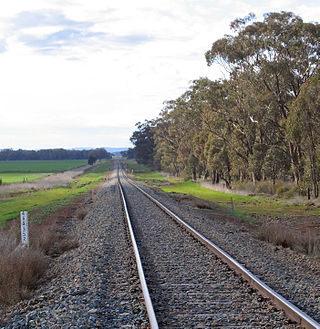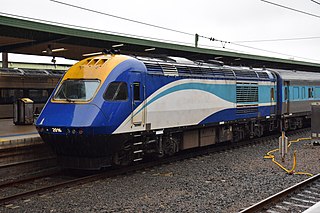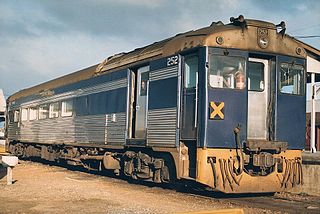
The 3000 class and 3100 class are a class of diesel railcars that operate on the Adelaide rail network. Built by Comeng and Clyde Engineering between 1987 and 1996, they entered service under the State Transport Authority before later being operated by TransAdelaide and Adelaide Metro. Trains are typically coupled as multiple units, though the 3000 class are also able to run as single units when needed. In total, 70 railcars were built and are expected to be retired between 2030 and 2032.

The Southern Highlands Line (SHL) is an intercity rail service that services the Macarthur, Southern Highlands and Southern Tablelands regions of New South Wales. First operating in 1869, the service runs from Campbelltown across the Main Southern railway line through to Goulburn, with peak hour services extending the route to Central. The railway service operates alongside a bus route from Picton to Bowral, operating on the route of the Picton – Mittagong loop railway line, and a regional coach service from Bundanoon to Wollongong on the South Coast Line, operating on the corridor of the Unanderra–Moss Vale railway line.

The Endeavour Railcars are a class of diesel multiple units (DMU) operated by Sydney Trains on its intercity passenger rail services in New South Wales, Australia on the Hunter, Blue Mountains, Southern Highlands and South Coast lines. They are mechanically identical to the Xplorers, but are fitted out for shorter travel distances. All 30 carriages were built by ABB's Dandenong rolling stock factory.

The 620/720 class railcars are a class of diesel-hydraulic multiple units (DHMU) built by the New South Wales Government Railways and operated from 1961 until 2007.
The Main Western Railway is a major railway in New South Wales, Australia. It runs through the Blue Mountains, and Central West regions. It is 825 kilometres (513 mi) long, of which 484 kilometres (301 mi) is currently operational.
The railways of New South Wales, Australia, use a large variety of passenger and freight rolling stock. The first railway in Sydney was opened in 1855 between Sydney and Granville, now a suburb of Sydney but then a major agricultural centre. The railway formed the basis of the New South Wales Government Railways. Passenger and freight services were operated from the beginning. By 1880, there was a half hourly service to Homebush.

The Gwabegar railway line is a railway line in the Central West and North West Slopes of New South Wales, Australia, which passes through the towns of Mudgee, Gulgong, Dunedoo, Coonabarabran and terminates at Gwabegar.

The Lake Cargelligo railway line is a railway line in Central Western New South Wales, Australia. The first sod was turned commencing construction on 8 June 1913 with the line opening on 13 November 1917. The line branches from the Main South line at Cootamundra and travels in a north-westerly direction to the small town of Lake Cargelligo. The line is used primarily for grain haulage, although passenger service was provided until 1983.

The New South Wales XPT is a class of diesel-powered passenger trains built by Comeng and ABB. Based on the British Rail-designed High Speed Train, each XPT set comprises two XP power cars in a push-pull configuration and, between them, between four and seven passenger carriages.

The Silver City Comet was a train service that operated from September 1937 until November 1989 between Parkes and Broken Hill in western New South Wales. It was the first air-conditioned train in Australia.

The 70 class were a class of diesel-hydraulic locomotives built by Commonwealth Engineering, Granville for the New South Wales Department of Railways in 1960–61. They were ordered to replace steam locomotives at Port Kembla.

A battery electric multiple unit (BEMU), battery electric railcar or accumulator railcar is an electrically driven multiple unit or railcar whose energy can be supplied from rechargeable batteries driving the traction motors.

The 900/800 class railcars were diesel multiple units built by the New South Wales Government Railways between November 1951 and November 1960.

The Bluebird railcars were a class of self-propelled diesel-hydraulic railcar built by the South Australian Railways' Islington Railway Workshops between 1954 and 1959.

The Rail Motor Society, based at Paterson, New South Wales, is a community owned collection of preserved self-propelled railway vehicles and equipment from the former New South Wales Government Railways and its successors. The items in its collection date from 1923 through to 1972.

The 400/500 class rail motors are diesel trains built by New South Wales Government Railways primarily for use on regional lines throughout NSW. The trains have since been phased out following a rationalisation of country branch line rail services in November 1983. The 400 Class power cars were built in 1938 at the Eveleigh Carriage Workshops, while the 500 Class trailer cars were built by Ritchie Brothers at Auburn.
The 660 & 760 class railcars are a class of diesel multiple unit train built by the New South Wales Government Railways (NSWGR) and used in the latter stages of their life by CityRail, primarily on its Hunter Valley line. The trains have since been phased out in favour of the newer Endeavour railcar model. The 660/760 railcars were converted by NSWGR from earlier 600/700 Class vehicles between 1973 and 1975.

The Riverina Express was a passenger train operated by the New South Wales Government Railways between Sydney, Griffith and Albury from September 1949 until November 1993.

The 1200 class railcar or Tulloch railcar were a type of diesel railcar built by Tulloch Limited for the New South Wales railways department between June 1970 and May 1972. They were built to operate the Riverina Express before being transferred to the South Coast Daylight Express.

The Byron Bay Train is a not-for-profit passenger rail service in Byron Bay, New South Wales, Australia. Since commencing in December 2017, it operates on a three-kilometre section of the disused Casino-Murwillumbah line.

















